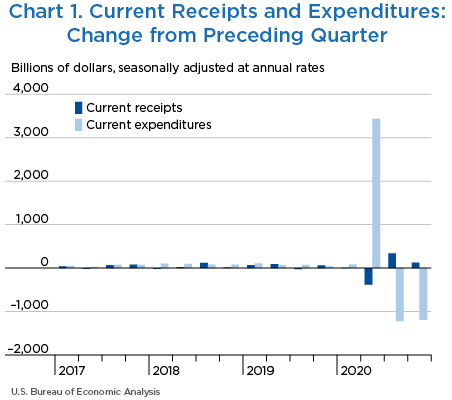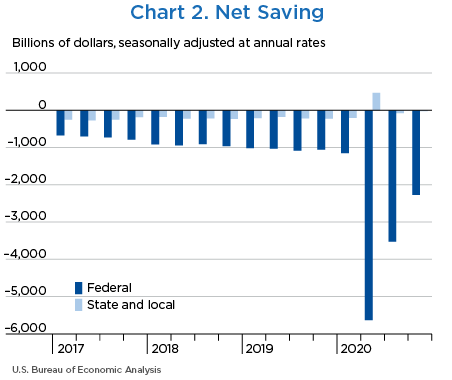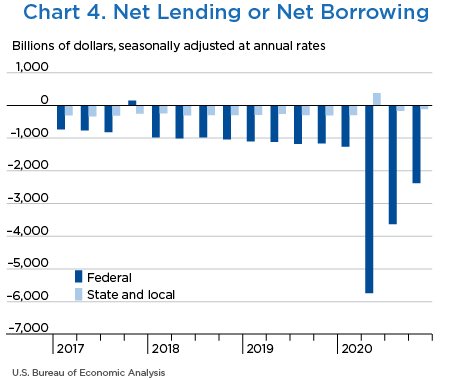Government Receipts and Expenditures
Fourth Quarter of 2020
Net government saving, the difference between current receipts and current expenditures in the federal government and state and local governments, was −$2,290.0 billion in the fourth quarter of 2020, increasing $1,315.3 billion from −$3,605.3 billion in the third quarter of 2020 (charts 1 and 2 and table 1).
“Net lending or net borrowing (−)” is an alternative measure of the government fiscal position. Net borrowing is the financing requirement of the government sector, and it is derived as net government saving plus the consumption of fixed capital and net capital transfers received less gross investment and net purchases of nonproduced assets.
Net borrowing was $2,495.7 billion in the fourth quarter, decreasing $1,297.4 billion from $3,793.1 billion in the third quarter (charts 3 and 4 and table 1).
| Line | Level | Change from preceding quarter | ||||
|---|---|---|---|---|---|---|
| 2020 | 2020 | 2020 | 2020 | 2020 | ||
| IV | I | II | III | IV | ||
| 1 | Current receipts | 5,987.5 | 6.0 | −383.6 | 337.8 | 123.1 |
| 2 | Current expenditures | 8,277.5 | 82.2 | 3,430.9 | −1,224.9 | −1,192.2 |
| 3 | Net government saving | −2,290.0 | −76.2 | −3,814.5 | 1,562.7 | 1,315.3 |
| 4 | Federal | −2,269.8 | −95.9 | −4,487.5 | 2,109.7 | 1,258.8 |
| 5 | State and local | −20.1 | 19.7 | 673.0 | −547.0 | 56.6 |
| 6 | Net lending or net borrowing (−) | −2,495.7 | −90.7 | −3,803.0 | 1,566.7 | 1,297.4 |
| 7 | Federal | −2,379.4 | −99.5 | −4,479.1 | 2,111.3 | 1,248.4 |
| 8 | State and local | −116.3 | 8.7 | 676.2 | −544.5 | 48.9 |
Net federal government saving was −$2,269.8 billion in the fourth quarter, increasing $1,258.8 billion from −$3,528.6 billion in the third quarter (table 2). In the fourth quarter, current receipts decelerated and current expenditures decreased less.
Federal government net borrowing was $2,379.4 billion in the fourth quarter, decreasing $1,248.4 billion from $3,627.8 billion in the third quarter.
- Personal current taxes (line 3) decelerated in the fourth quarter, reflecting a deceleration in withheld taxes and a downturn in nonwithheld taxes. The deceleration in withheld taxes reflects the pattern of wages. The downturn in nonwithheld taxes reflects a downturn in nonwage income.
- Taxes on production and imports (line 4) decelerated in the fourth quarter. Excise taxes decelerated, reflecting downturns in taxes on gasoline, tobacco, and diesel fuel. These downturns were partially offset by an upturn in alcohol excise taxes and an acceleration in air transport taxes. Within taxes on production and imports, customs duties also decelerated in the fourth quarter, increasing $5.1 billion after increasing $6.3 billion in the third quarter, primarily reflecting a deceleration in the volume of imports.
- Taxes on corporate income (line 5) decelerated in the fourth quarter, reflecting a downturn in corporate profits.
- Contributions for government social insurance (line 7) decelerated in the fourth quarter, reflecting the pattern of wages.
- Income receipts on assets (line 8) turned down in the fourth quarter, reflecting a downturn in dividends from the Federal Reserve banks that was partially offset by an upturn in rents and royalties.
- Current transfer receipts (line 9) accelerated in the fourth quarter, reflecting a $1.8 billion ($7.2 billion at an annual rate) settlement with Goldman Sachs for violating anti-bribery laws.
- Nondefense consumption expenditures (line 14) decreased less in the fourth quarter. Nondefense services decreased less, reflecting a decrease in Paycheck Protection Program (PPP) fees paid to private lenders. The smaller decrease was partially offset by a downturn in compensation of general government employees. In the third quarter, compensation of general government employees was boosted by an increase in spending for temporary and intermittent decennial census workers.
- Government social benefits to persons (line 17) decreased less in the fourth quarter, decreasing $576.6 billion after decreasing $1.3 trillion in the third quarter. The smaller decrease in the fourth quarter reflects the pattern of economic impact payments to individuals authorized by the Coronavirus Aid, Relief, and Economic Security (CARES) Act, which were mostly distributed in the second quarter. Transfers to nonprofits decreased less, reflecting a smaller decrease in transfers from the Public Health and Social Services Emergency Fund authorized by the CARES Act. The lost wages supplemental payments program, which provides additional unemployment benefits from the Federal Emergency Management Agency Disaster Relief Fund, turned down in the fourth quarter. Additionally, unemployment benefits continued to decrease, reflecting the July 25, 2020, expiration of pandemic unemployment compensation payments, which provided a temporary weekly supplemental benefit of $600 to people receiving unemployment. Supplemental Nutrition Assistance Program benefits turned down in the fourth quarter.
- Grants-in-aid to state and local governments (line 20) turned up in the fourth quarter, reflecting the pattern of spending for various COVID-19 response efforts appropriated through the CARES Act. Most of these funds were disbursed in the second quarter through the Coronavirus Relief Fund. Grants for health from the Provider Relief Fund and grants for education from the Education Stabilization Fund decreased less in the fourth quarter.
- Subsidies (line 23) turned down in the fourth quarter, reflecting a decrease in funds appropriated through the CARES Act. Notably, PPP loans to businesses turned down. In the initial round of PPP loans, most loans were approved in April and May of 2020 and were intended to cover expenses for 24 weeks.
| Line | Level | Change from preceding quarter | ||||
|---|---|---|---|---|---|---|
| 2020 | 2020 | 2020 | 2020 | 2020 | ||
| IV | I | II | III | IV | ||
| 1 | Current receipts | 3,756.1 | −10.6 | −284.3 | 208.3 | 79.0 |
| 2 | Current tax receipts | 2,134.4 | −27.1 | −220.3 | 134.3 | 70.4 |
| 3 | Personal current taxes | 1,717.7 | 16.4 | −156.5 | 84.9 | 32.7 |
| 4 | Taxes on production and imports | 150.8 | 4.6 | −52.4 | 13.3 | 6.1 |
| 5 | Taxes on corporate income | 236.9 | −49.2 | −9.0 | 35.5 | 29.9 |
| 6 | Taxes from the rest of the world | 29.0 | 1.2 | −2.5 | 0.7 | 1.7 |
| 7 | Contributions for government social insurance | 1,445.8 | 19.5 | −62.2 | 52.4 | 19.2 |
| 8 | Income receipts on assets | 110.4 | 1.6 | −5.4 | 20.3 | −17.3 |
| 9 | Current transfer receipts | 65.5 | −5.7 | 3.1 | 0.6 | 7.0 |
| 10 | Current surplus of government enterprises | 0.0 | 1.0 | 0.6 | 0.7 | −0.3 |
| 11 | Current expenditures | 6,025.9 | 85.3 | 4,203.2 | −1,901.5 | −1,179.7 |
| 12 | Consumption expenditures | 1,142.9 | 4.3 | 50.1 | −27.1 | 1.9 |
| 13 | National defense | 712.0 | 1.0 | −2.4 | 11.6 | 11.9 |
| 14 | Nondefense | 430.9 | 3.3 | 52.6 | −38.8 | −10.0 |
| 15 | Current transfer payments | 3,734.8 | 89.8 | 3,164.2 | −1,988.6 | −570.5 |
| 16 | Government social benefits | 2,946.3 | 75.3 | 2,402.0 | −1,326.4 | −576.7 |
| 17 | To persons | 2,918.2 | 74.8 | 2,392.8 | −1,320.4 | −576.7 |
| 18 | To the rest of the world | 28.1 | 0.5 | 9.2 | −6.0 | 0.0 |
| 19 | Other current transfer payments | 788.5 | 14.6 | 762.3 | −662.3 | 6.2 |
| 20 | Grants-in-aid to state and local governments | 738.1 | 12.4 | 769.1 | −668.7 | 9.9 |
| 21 | To the rest of the world | 50.3 | 2.2 | −6.8 | 6.4 | −3.8 |
| 22 | Interest payments | 538.5 | −2.8 | −22.6 | −12.6 | −8.0 |
| 23 | Subsidies | 609.8 | −6.0 | 1,011.4 | 127.0 | −603.1 |
| 24 | Net federal government saving | −2,269.8 | −95.9 | −4,487.5 | 2,109.7 | 1,258.8 |
| 25 | Social insurance funds | −781.1 | −29.5 | −1,134.8 | 338.3 | 470.2 |
| 26 | Other | −1,488.8 | −66.4 | −3,352.7 | 1,771.4 | 788.5 |
| Addenda: | ||||||
| 27 | Total receipts | 3,773.8 | −9.4 | −283.8 | 208.6 | 79.1 |
| 28 | Current receipts | 3,756.1 | −10.6 | −284.3 | 208.3 | 79.0 |
| 29 | Capital transfer receipts | 17.7 | 1.2 | 0.5 | 0.3 | 0.1 |
| 30 | Total expenditures | 6,153.2 | 90.1 | 4,195.3 | −1,902.5 | −1,169.4 |
| 31 | Current expenditures | 6,025.9 | 85.3 | 4,203.2 | −1,901.5 | −1,179.7 |
| 32 | Gross government investment | 350.5 | 0.3 | 2.1 | 9.4 | 4.4 |
| 33 | Capital transfer payments | 87.0 | 6.3 | −7.3 | 2.8 | −0.9 |
| 34 | Net purchases of nonproduced assets | −0.2 | 0.4 | 0.4 | −11.0 | 10.9 |
| 35 | Less: Consumption of fixed capital | 310.0 | 2.2 | 3.1 | 2.3 | 4.1 |
| 36 | Net lending or net borrowing (−) | −2,379.4 | −99.5 | −4,479.1 | 2,111.3 | 1,248.4 |
Net state and local government saving was −$20.1 billion in the fourth quarter, increasing $56.6 billion from −$76.7 billion in the third quarter. In the fourth quarter, current receipts turned up and current expenditures turned down (table 3).
State and local government net borrowing was $116.3 billion, decreasing $48.9 billion from $165.2 billion in the third quarter.
- Taxes on production and imports (line 4) decelerated in the fourth quarter, reflecting a deceleration in sales taxes and a downturn in excise taxes.
- Taxes on corporate income (line 5) decelerated in the fourth quarter, reflecting a downturn in corporate profits.
- Federal grants-in-aid (line 9) turned up in the fourth quarter, reflecting the pattern of spending for various COVID-19 response efforts appropriated through the CARES Act. Most of these funds were disbursed in the second quarter through the Coronavirus Relief Fund. Grants for health from the Provider Relief Fund and grants for education from the Education Stabilization Fund decreased less in the fourth quarter.
- Current surplus of government enterprises (line 11) decelerated in the fourth quarter, reflecting a deceleration in sales revenue by government enterprises, including decelerations in revenue from toll roads and public transit.
- Consumption expenditures (line 13) turned up in the fourth quarter, reflecting a deceleration in sales to other sectors, specifically health and hospital charges.
- Government social benefits (line 14) turned down in the fourth quarter, reflecting a downturn in Medicaid benefits.
| Line | Level | Change from preceding quarter | ||||
|---|---|---|---|---|---|---|
| 2020 | 2020 | 2020 | 2020 | 2020 | ||
| IV | I | II | III | IV | ||
| 1 | Current receipts | 2,969.6 | 29.1 | 669.7 | −539.2 | 54.1 |
| 2 | Current tax receipts | 1,981.2 | 22.3 | −89.8 | 126.4 | 39.9 |
| 3 | Personal current taxes | 524.5 | 14.9 | 0.6 | 10.1 | 18.0 |
| 4 | Taxes on production and imports | 1,360.8 | 15.8 | −81.9 | 80.2 | 16.3 |
| 5 | Taxes on corporate income | 95.9 | −8.3 | −8.5 | 36.0 | 5.7 |
| 6 | Contributions for government social insurance | 21.8 | −0.7 | −1.3 | 1.1 | 1.6 |
| 7 | Income receipts on assets | 98.7 | 0.2 | 0.1 | 0.1 | 0.7 |
| 8 | Current transfer receipts | 887.4 | 13.2 | 769.9 | −667.9 | 11.6 |
| 9 | Federal grants-in-aid | 738.1 | 12.4 | 769.1 | −668.7 | 9.9 |
| 10 | Other | 149.3 | 0.8 | 0.8 | 0.8 | 1.7 |
| 11 | Current surplus of government enterprises | −19.7 | −5.9 | −9.1 | 1.1 | 0.1 |
| 12 | Current expenditures | 2,989.7 | 9.4 | −3.3 | 7.9 | −2.6 |
| 13 | Consumption expenditures | 1,883.6 | 9.2 | −43.0 | −3.8 | 2.4 |
| 14 | Government social benefits | 827.6 | 6.1 | 45.1 | 16.3 | −0.9 |
| 15 | Interest payments | 277.9 | −5.9 | −5.3 | −4.7 | −4.1 |
| 16 | Subsidies | 0.6 | 0.0 | 0.0 | 0.0 | 0.0 |
| 17 | Net state and local government saving | −20.1 | 19.7 | 673.0 | −547.0 | 56.6 |
| 18 | Social insurance funds | 5.7 | −1.0 | −1.5 | 0.9 | 1.4 |
| 19 | Other | −25.8 | 20.7 | 674.5 | −547.9 | 55.2 |
| Addenda: | ||||||
| 20 | Total receipts | 3,049.0 | 31.8 | 673.9 | −541.8 | 53.9 |
| 21 | Current receipts | 2,969.6 | 29.1 | 669.7 | −539.2 | 54.1 |
| 22 | Capital transfer receipts | 79.5 | 2.8 | 4.1 | −2.6 | −0.1 |
| 23 | Total expenditures | 3,165.4 | 23.1 | −2.3 | 2.7 | 5.1 |
| 24 | Current expenditures | 2,989.7 | 9.4 | −3.3 | 7.9 | −2.6 |
| 25 | Gross government investment | 458.1 | 15.1 | −4.0 | −1.2 | 9.7 |
| 26 | Capital transfer payments | |||||
| 27 | Net purchases of nonproduced assets | 24.9 | 1.2 | 5.8 | 0.3 | 0.4 |
| 28 | Less: Consumption of fixed capital | 307.4 | 2.4 | 0.9 | 4.3 | 2.5 |
| 29 | Net lending or net borrowing (−) | −116.3 | 8.7 | 676.2 | −544.5 | 48.9 |



